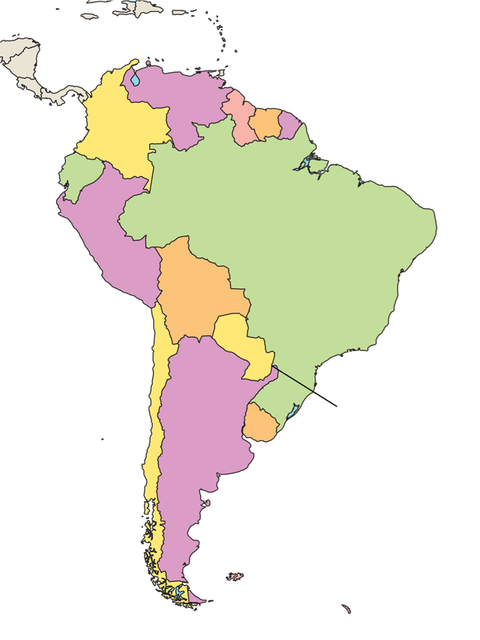Throughthehotandhumidrainforest,IcouldheartheroarofDevil’s Throat.
Imovedforwardtotheedgeofthefootbridge.Lookingover,Icouldseethegiantwaterfall.Mistfromthewaterroseintotheair.Soon,Iwassoaking wet.
ThemightyIguazúRiverfellovertherockycliff.Itwas breathtaking.
GreatWater
IguazúFallsgotitsnamefromtheGuaranípeople.Itsnamemeans“greatwater.”Theamountofwatertherivercarriesoverthefallsis great.
TheIguazúRiverflowsatarapidrate.Itisoneofthelargestwaterfallsintheworld.ItspanstheborderofArgentinaandBrazil.Duringtherainyseason,upto
275differentwaterfallscan form.

Iguazú Falls
Atlantic
Ocean
Pacific
Ocean
Brazil
Paraguay
Argentina
South
America
MostofthefallsareontheArgentinasideoftheriver.IcrossedtheborderintoBrazil.Iraceduptheriverinaspeedboat.Theboatslowedatthefootofseveralwaterfalls.Thatgavemegreat view.
It’shardtoappreciatethefallsuntilyouseethemyourself.OneU.S.firstladythoughttheywerebetterthanNiagaraFallsintheUnited States!
Seenfromtheair,Devil’sThroatdividesArgentinaand Brazil.

trailtoDevil’s Throat
Argentina
Brazil
Devil’s Throat
LegendoftheFalls
Legendtellshowthefallscametobe.Longago,theserpentgodM’BoilivedintheIguazúRiver.Hewasanangrygod.Eachyear,thepeoplemadeasacrificetoquiethim.Theythrewayoungwomanintothe water.
Oneyear,thetribechoseNaipi.Naipiwasinlovewiththewarrior,Tarobá.SheandTarobátriedtoescapeina canoe.
But,M’Boisawthem.Hesplittheearth,creatingarockygorge.ItbecameDevil’sThroat.HethrewNaipitoonesideofthegorgeandchangedherintoarock.Tarobátriedtohelpher.But,M’Boipulledhishandsintotheearth.There,hisfingersturnedintoroots.Hisbodybecameatree.Andso,NaipiandTarobácanmeetonlyovera rainbow.
Arainbowbridgesthe falls.